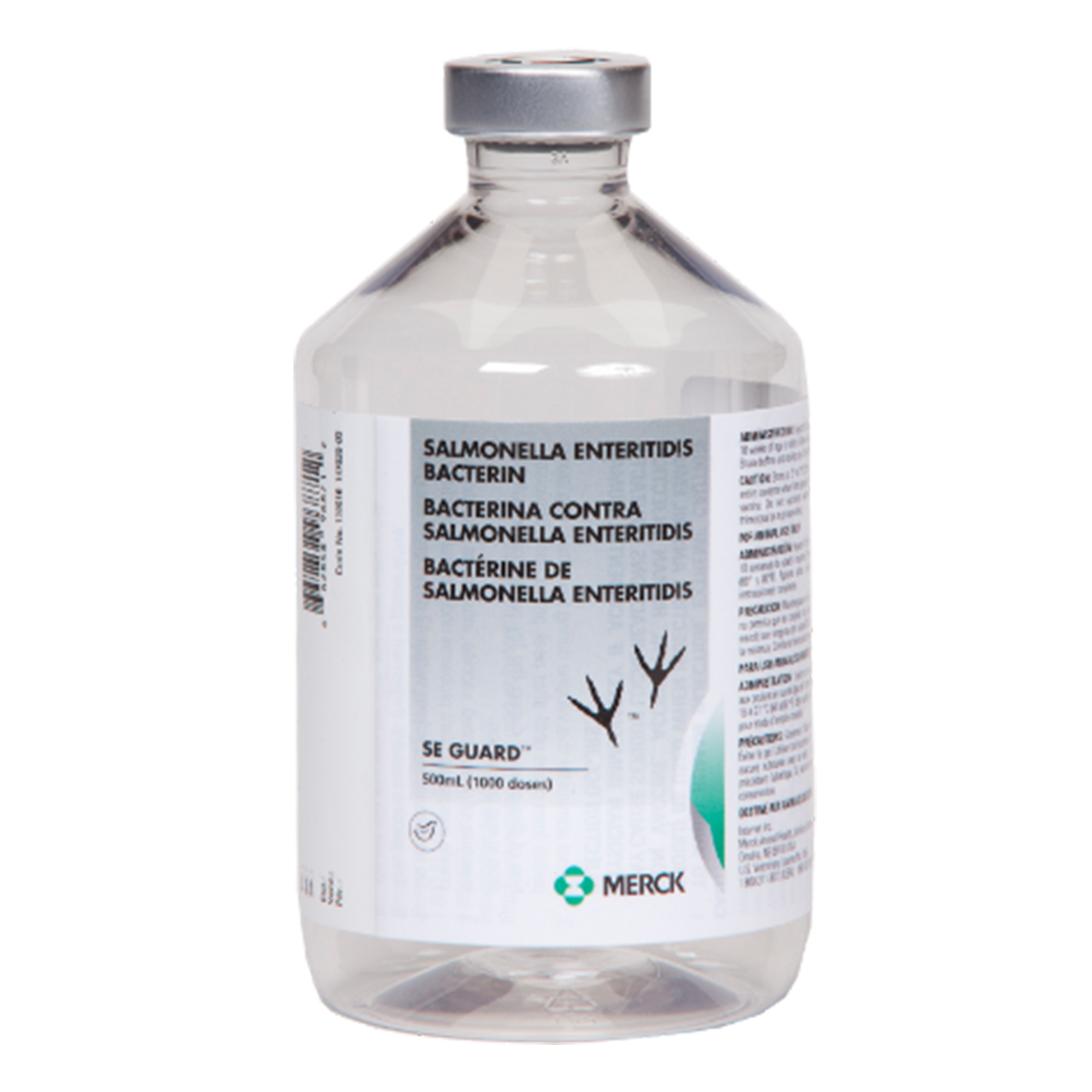SE GUARD®
Salmonella Enteritidis Bacterin
Product Description
SE Guard® is prepared from Salmonella Enteritidis (SE), inactivated and suspended in the aqueous phase of an oil adjuvant emulsion.


Indications
SE Guard has been shown to be effective for the vaccination of healthy chickens 10 weeks of age or older against Salmonella enteritidis phage types 4, 8, & 13a.
SE Guard has been shown to be effective against colonization of internal organs, including the reproductive tract.
Advantages
When administered to pullets, SE GUARD®:
- Aids in the reduction of SE, phage types 4, 8 and 13a colonization of the reproductive tract
- Aids in the reduction of SE, phage types 4, 8 and 13a colonization of internal organs
Diseases/Parasites
- Salmonella enteritidis (SE)
- Salmonella enteritidis (SE) Phage type 4
- Salmonella enteritidis (SE) Phage type 8
- Salmonella enteritidis (SE) Phage type 13a
Vaccination Programs
Many factors must be considered in determining the vaccination program for a particular farm or poultry operation. To be fully effective, the vaccine must be administered to healthy receptive birds held in proper environment under good management. In addition, the response may be modified by the age of the birds and their immune status. Seldom does 1 vaccination under field conditions produce complete protection for all individuals in a given flock. The amount of protection required will vary with the type of operation and the degree of exposure that a flock is likely to encounter.
Administration
Allow the vaccine to reach ambient temperature, 16° to 27°C (60° to 80°F), shake well before use and periodically during use. Inject 0.5 ml subcutaneously in chickens in the back of the neck midway between the head and body in a direction away from the head using an 18-gauge needle. Do not inject into muscle tissue or neck vertebrae. Vaccinate healthy chickens at least 10 weeks of age. A second vaccination is recommended a minimum of 6 weeks following initial vaccination.
The use of any inactivated vaccine may cause false positive results on Mycoplasma plate tests. Avoid Mycoplasma testing prior to ten weeks post-vaccination. The use of S. enteritidis vaccines may interfere with avian pullorum-typhoid testing. It is recommended that vaccination occur after testing is complete.
Supplied
500mL (1000 doses)
Cautions
- TO AVOID HUMAN INJECTION, EXTREME CAUTION SHOULD BE USED WHEN INJECTING ANY OIL EMULSION VACCINE. ACCIDENTAL HUMAN INJECTION MAY CAUSE SERIOUS LOCAL REACTIONS. CONTACT A PHYSICIAN IMMEDIATELY IF ACCIDENTAL HUMAN INJECTION OCCURS.
- Do not administer this vaccine during the critical egg laying period from onset until after peak production. Administration of this product during the lay period may result in a drop in egg production.
- Injection of inactivated vaccine into breast muscle may create processing plant problems under certain conditions.
- Ensure that vaccination equipment is clean and sterile before use.
- Do not use vaccination equipment with rubber parts, as the oil emulsion may attack certain types of rubber.
- Use entire contents when first opened.
- Do not vaccinate within 42 days before slaughter.
- Store at 2° to 8°C (35° to 46°F) in the dark.
- Do not mix with other products.
- In case of human exposure, contact a physician.
- Contains thimerosal as a preservative.
- FOR ANIMAL USE ONLY.
Notice
This vaccine has undergone rigid potency, safety and purity tests, and meets Merck Animal Health, U.S. and local requirements. It is designed to stimulate effective immunity when used as directed, but the user must be advised that the response to the product depends upon many factors, including, but not limited to, conditions of storage and handling by the user, administration of the vaccine, health and responsiveness of individual chickens and the degree of field exposure. Therefore, directions should be followed carefully. This product is not hazardous when used according to directions supplied. A safety data sheet (SDS) is available upon request. This and any other consumer information can be obtained by calling Merck Animal Health Customer Service at 1-800-211-3573.
Records
Keep a record of vaccine, quantity, serial number, expiration date, and place of purchase; the date and time of vaccination; the number, age, breed, and locations of chickens; names of operators performing the vaccination and any observed reactions.
Contact our sales or technical services representatives to help design a custom vaccination program.
Resources
For additional information, please see the product label.
For more information regarding efficacy and safety data, go to productdata.aphis.usda.gov.
References
*Data on file, Merck Animal Health

To view our complete product lineup, click to view our
POULTRY PRODUCT CATALOG vol. 3.1.

